Truth: The ancient Greeks got it wrong when they called diamond “Adamas” – meaning indestructible – because a diamond can be damaged if a blow of sufficient force is applied in an exact direction. A diamond can crack, split or shatter due to atomic planes of relative weakness called cleavage planes. These planes allow diamonds to be cut by impact and fashioned into different shapes.
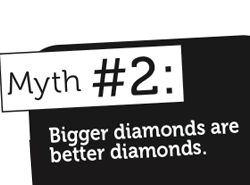 Truth: A large diamond may leave them standing in the aisles, but only if its quality is equally impressive. Factors such as colour, clarity, cut quality, shape and light-return are important considerations, rather than just size alone. The brilliance and fire of a beautifully-cut small diamond of good quality will always outperform a large, dull, poorly-cut diamond.
Truth: A large diamond may leave them standing in the aisles, but only if its quality is equally impressive. Factors such as colour, clarity, cut quality, shape and light-return are important considerations, rather than just size alone. The brilliance and fire of a beautifully-cut small diamond of good quality will always outperform a large, dull, poorly-cut diamond.
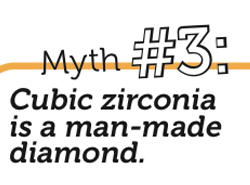 Truth: These are two completely different gemstones that are manufactured in a laboratory. Cubic zirconia – zirconium oxide – is an artificial gem that has no known natural counterpart and may be used to imitate the appearance of diamond but does not share the same properties. Man-made diamond – crystallised carbon – has the same chemical composition and physical structure as natural diamond.
Truth: These are two completely different gemstones that are manufactured in a laboratory. Cubic zirconia – zirconium oxide – is an artificial gem that has no known natural counterpart and may be used to imitate the appearance of diamond but does not share the same properties. Man-made diamond – crystallised carbon – has the same chemical composition and physical structure as natural diamond.
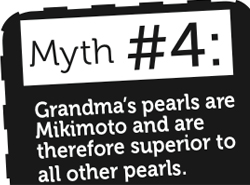 Truth: Beware of wisdom “handed down” with family heirlooms. Mikimoto refers to a brand name, not a species of oyster. After all, the pearls themselves have no idea for whom they are growing. Kokichi Mikimoto, the “father” of the pearling industry, successfully produced good quality, Japanese akoya cultured pearls grown by the Pinctada Fucata oyster from the early 20th century onwards.
Truth: Beware of wisdom “handed down” with family heirlooms. Mikimoto refers to a brand name, not a species of oyster. After all, the pearls themselves have no idea for whom they are growing. Kokichi Mikimoto, the “father” of the pearling industry, successfully produced good quality, Japanese akoya cultured pearls grown by the Pinctada Fucata oyster from the early 20th century onwards.
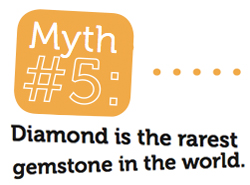 Truth: Although large, high-quality fancy-coloured diamonds are rare, diamonds themselves are quite common and are in plentiful supply. Among the contenders for rarest gemstone are bixbite, musgravite, grandidierite, painite, serendibite, jeremejevite, benitoite and taaffeite.
Truth: Although large, high-quality fancy-coloured diamonds are rare, diamonds themselves are quite common and are in plentiful supply. Among the contenders for rarest gemstone are bixbite, musgravite, grandidierite, painite, serendibite, jeremejevite, benitoite and taaffeite.
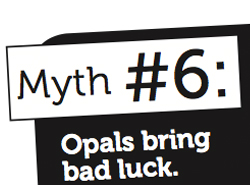 Truth: This myth is based on superstition and folklore. There are many stories connecting opal with good luck. For example, the ancient Romans believed opal was a good luck charm that brought its owner good fortune. In Australian Aboriginal legend, opal was dubbed the Rainbow Serpent and admired for its unique energy and beauty.
Truth: This myth is based on superstition and folklore. There are many stories connecting opal with good luck. For example, the ancient Romans believed opal was a good luck charm that brought its owner good fortune. In Australian Aboriginal legend, opal was dubbed the Rainbow Serpent and admired for its unique energy and beauty.
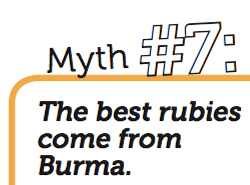 Truth: Geographical origin is not a guarantee of quality. Burma has produced rubies in a huge range of qualities – from bright, clean pigeon blood red through to dull, opaque, cloudy material suitable for a fish tank. Other locations such as Madagascar and Mozambique have produced rubies of equal beauty.
Truth: Geographical origin is not a guarantee of quality. Burma has produced rubies in a huge range of qualities – from bright, clean pigeon blood red through to dull, opaque, cloudy material suitable for a fish tank. Other locations such as Madagascar and Mozambique have produced rubies of equal beauty.
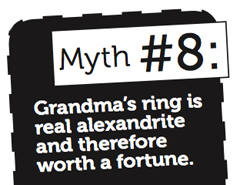 Truth: Alexandrite is a natural red/green colour change gem that is rare to find in large sizes and can be extremely expensive. A more common gemstone is synthetic corundum imitating alexandrite. This is manufactured inexpensively in very large sizes and has been in production since the early 20th century.
Truth: Alexandrite is a natural red/green colour change gem that is rare to find in large sizes and can be extremely expensive. A more common gemstone is synthetic corundum imitating alexandrite. This is manufactured inexpensively in very large sizes and has been in production since the early 20th century.
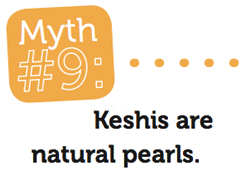 Truth: Although highly-prized, Keshis are not natural pearls. They are a natural by-product of the culturing process that involves human intervention, whereas natural pearls are formed by chance and without human intervention.
Truth: Although highly-prized, Keshis are not natural pearls. They are a natural by-product of the culturing process that involves human intervention, whereas natural pearls are formed by chance and without human intervention.
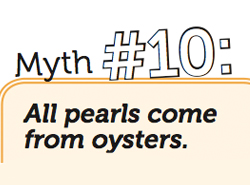 Truth: Although the majority of commercially-produced gem-quality pearls are cultured from oysters or mussels, other species can produce pearls – the orange-to-brown Melo pearl comes from the Melo Melo marine snail; the pink conch pearl from the Queen conch Strombas Gigas; the blue-purple-green iridescent Abalone pearl comes from the Haliotis Iris mollusc.
Truth: Although the majority of commercially-produced gem-quality pearls are cultured from oysters or mussels, other species can produce pearls – the orange-to-brown Melo pearl comes from the Melo Melo marine snail; the pink conch pearl from the Queen conch Strombas Gigas; the blue-purple-green iridescent Abalone pearl comes from the Haliotis Iris mollusc.
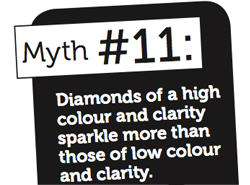 Truth: Not so. It is the cut quality that creates sparkle, not the clarity or colour. When light enters the crown of a well-proportioned diamond, it is internally reflected back up through the crown facets to create brilliance or sparkle, while the breaking up of white light into its spectral colours creates dispersion.
Truth: Not so. It is the cut quality that creates sparkle, not the clarity or colour. When light enters the crown of a well-proportioned diamond, it is internally reflected back up through the crown facets to create brilliance or sparkle, while the breaking up of white light into its spectral colours creates dispersion.
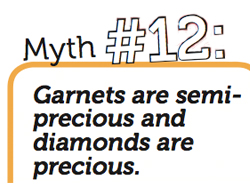 Truth: Many people believe stones such as diamond, sapphire, ruby and emerald are precious because they are rare, expensive or famous; however, World Jewellery Confederation CIBJO states that the term ”semi-precious” is misleading. This is because a gemstone traditionally perceived as semi-precious, such as garnet, may be worth more in a high quality or size than a precious diamond of low quality.
Truth: Many people believe stones such as diamond, sapphire, ruby and emerald are precious because they are rare, expensive or famous; however, World Jewellery Confederation CIBJO states that the term ”semi-precious” is misleading. This is because a gemstone traditionally perceived as semi-precious, such as garnet, may be worth more in a high quality or size than a precious diamond of low quality.
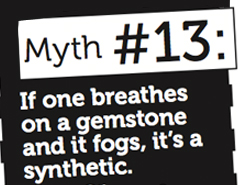 Truth: Otherwise known as the ”breath test”, this is a totally unreliable method used to separate diamond from its imitations. Based on the theory that condensation should not occur on a natural diamond because of its high thermal conductivity, it ignores the fact that synthetic diamond, moissanite and sapphire also have a high thermal conductivity.
Truth: Otherwise known as the ”breath test”, this is a totally unreliable method used to separate diamond from its imitations. Based on the theory that condensation should not occur on a natural diamond because of its high thermal conductivity, it ignores the fact that synthetic diamond, moissanite and sapphire also have a high thermal conductivity.
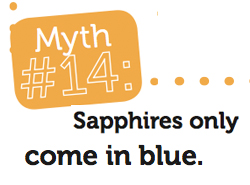 Truth: Sapphire belongs to the corundum family and may occur in a rainbow of different colours. The red variety is called ruby while any other colour is described as a sapphire immediately preceded by its colour – pink sapphire, for example. Sapphires can have distinctly different colour zones, such as blue and yellow, and these are called “parti-coloured” sapphires.
Truth: Sapphire belongs to the corundum family and may occur in a rainbow of different colours. The red variety is called ruby while any other colour is described as a sapphire immediately preceded by its colour – pink sapphire, for example. Sapphires can have distinctly different colour zones, such as blue and yellow, and these are called “parti-coloured” sapphires.
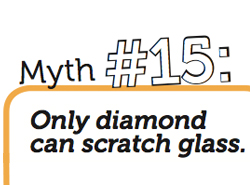 Truth: This myth implies that any gemstone able to scratch glass must be diamond; however, any gem material equal to, or greater than, the hardness of glass, which has a rating of 6 on Mohs scale, will also scratch it. Quartz, tourmaline, topaz, garnet, sapphire, diamond and, of course, glass are all examples.
Truth: This myth implies that any gemstone able to scratch glass must be diamond; however, any gem material equal to, or greater than, the hardness of glass, which has a rating of 6 on Mohs scale, will also scratch it. Quartz, tourmaline, topaz, garnet, sapphire, diamond and, of course, glass are all examples.
Prepared in conjunction with the Gemmological Association of Australia (GAA) with thanks to Megan Austin, FGAA.

